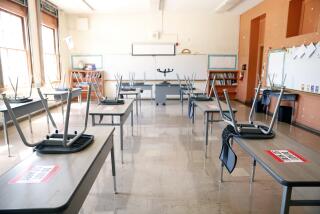Children Correspond Across U.S. : Computer Network Turns Students Into Journalists
- Share via
NEW HAVEN, Conn. — In classrooms throughout North America and beyond, young fingers are tapping on computer keyboards, writing dispatches that other kids in distance places will edit and publish.
“It’s like a news wire; the students publish newspapers,” said Dennis Sayers, New England coordinator of Computer Mail System-Schoolnet, an international educational computer network.
“Instead of using computers to play ‘Star Wars’ and other questionable pedagogical activities, the computer becomes a Teletype.”
The purpose, Sayers said, is to improve writing skills. Students in the second grade through college are involved in the network, which got its start three years ago in San Diego, he said.
More Than 200 Involved
More than 200 teachers and students are now involved. Classes from the United States, Canada, Japan, Argentina, Mexico and Israel participate, according to Sayers.
“Usually what happens is that a class hooks up with another class on the network and they become sister classes. The two teachers really have to work together,” said Sayers, a lecturer in education at the University of Hartford and a doctoral student at the Harvard Graduate School of Education.
In New Haven, Arthur Solis’ bilingual fourth- and fifth-grade class at the Truman School has become partners with Michelle Gonsalves’ fourth-grade class in Valley Center Elementary School in Valley Center, Calif.
The students began by writing individually to each other on the computer in English and Spanish and using the network to transmit the messages.
Now the classes are producing a newspaper, with students on one coast editing the work of their counterparts on the other.
Interviews, Reviews
Subjects include interviews with teachers and parents, travel pieces describing the classes’ cities, and music reviews.
“There are articles on drug abuse and other kinds of sensitive issues,” Sayers said.
Sayers, who is writing his dissertation on the network, said he has seen students’ writing skills improve. Knowing that their work will be published, students want to make sure they have good ideas and do not have any errors in their articles, he said.
A recent theory about the teaching of writing is called process writing, and it reflects the work styles of newspaper reporters and editors, Sayers said. First, ideas are encouraged and then attention is focused on revising, correcting spelling and grammar.
“It pretty much what happens in the newspaper,” he said. “You have to have a good lead (story beginning) and a good article and you don’t worry as much about the copy editing until the end.”
To join the computer network, a school must have a personal Apple computer and a modem, a device that allows computers to transmit messages over telephone lines, Sayers said.
The network enables toll-call savings because it uses a kind of chain-link approach in transmitting messages, Sayers said.
A school makes just one call to a designated gateway computer in its region which then calls the next link in the network. It may take several steps for the students’ work to reach its destination.
‘Like a Spider Plant’
“It’s like a spider plant that throws a branch off which plants itself and throws another branch off,” Sayers said.
In addition to working on their writing skills, Truman School students are are learning geography.
Solis said they had little understanding of the distance between them and their sister class. Now hanging on the classroom wall is a map of the United States with a line drawn between Southern California and Connecticut.
Sayers has been traveling throughout New England talking about the network with copies of about 100 newsletters produced through it.
“This is a kind of let-your-imagination-roll thing,” he said. “That is the way the teachers treat it anyways.”
More to Read
Sign up for Essential California
The most important California stories and recommendations in your inbox every morning.
You may occasionally receive promotional content from the Los Angeles Times.













